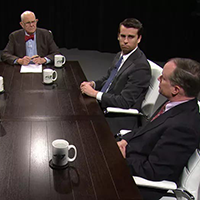Health costs drive our budget debates
Published October 9, 2025
By John Hood
While the government shutdown in Washington and the state budget impasse in Raleigh involve different actors and effects, there is a common denominator: the extent to which debates about public finance are really debates about health care costs.
When Democrats in Congress refused to support a continuing resolution to keep all federal agencies open, their stated goals were to rescind previously enacted Medicaid savings and to protect generous subsidies provided since 2020 to middle-income families enrolled in Affordable Care Act plans.
And when Republicans in the North Carolina General Assembly refused to appropriate as much new money to Medicaid as Democratic Gov. Josh Stein said was needed, the Stein administration began slashing reimbursement rates to hospitals, doctors, and other medical providers.
Even the broader disagreement between the North Carolina House and Senate about tax cuts is to a large extent a disagreement about how to balance other fiscal responsibilities against the rising cost of health services for public employees and Medicaid recipients.
Both GOP-led chambers want to keep reducing income-tax rates over time. Where they differ is pacing. Mindful of recently revised revenue forecasts, House leaders worry about potential deficits in 2027 and beyond. Skeptical of those forecasts, Senate leaders want to stick with a tax-cut schedule set in 2023.
I have my own views about these policy disputes and how to resolve them. I’ve repeatedly expressed them. That’s my job! Today, however, I simply want to underline a distinction that too many politicians of both parties deny or downplay: the price of health care isn’t necessarily equivalent to the cost of health care.
A patient may pay $75 to see her physician, for example, but that’s not even close to the full cost of the service. The physician bills her health plan. Outpatient procedures, hospital stays, prescription drugs — in nearly every case, the price consumers see and pay out of pocket is but a small fraction of the total cost that consumers pay directly but not contemporaneously (in the form of insurance premiums) or that consumers pay indirectly (by accepting lower wages in exchange for employers paying the insurance premiums on their behalf).
Government subsidies further widen the gap between price and cost. Some of these subsidies are, again, direct but not contemporaneous. Medicaid, Medicare, and other public programs receive present or future taxes and then pay providers for services rendered. Other government subsidies are indirect, the most sizable being the fact that wages are taxable but non-wage benefits such as health plans are not taxable.
These subsidies are staggering. The fiscal impact of the federal tax exclusion for health benefits is worth more than $300 billion a year. State exclusions in jurisdictions such as North Carolina that tax personal income add many more billions to that total.
As for direct expenditures, Medicaid and Medicaid are the fastest-growing major categories of federal spending. In 1950, health care expenditures comprised all of 2% of the federal budget. In 2024, it was 25%. And as American Enterprise Institute senior fellow James Capretta pointed out in a recent piece, the extra ACA subsidies that congressional Democrats are fighting hard to retain will cost federal taxpayers an average of $35 billion a year over the next decade.
All too often, when politicians say they want to reduce the cost of health care, what they really mean is the price. They simply want to shift the cost from one set of payers to another — in this case, from households to taxpayers. That may please some constituencies and anger others. But it is no solution to chronic deficits.
“Subsidizing insurance enrollment can stabilize coverage for a time,” Capretta observed, “but it does nothing to lower the overall cost of health care, and, in many cases, it can increase costs by encouraging consumption of low-value or care that could have been avoided with better prevention.”
Last year, the average cost of employment-based health coverage was $25,572 per family. We need to reduce it, not just shift it.
John Hood is a John Locke Foundation board member. His books Mountain Folk, Forest Folk, and Water Folk combine epic fantasy and American history.







